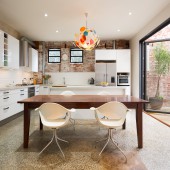Skipping-Girl Vinegar-Vats House and Architecture Studio by Adrian Light |
Home > Winners > #103632 |
 |
|
||||
| DESIGN DETAILS | |||||
| DESIGN NAME: Skipping-Girl Vinegar-Vats PRIMARY FUNCTION: House and Architecture Studio INSPIRATION: Built in 1890, the building was a vinegar-making factory for the iconic Skipping Girl Vinegar brand. The light filled building was designed to be sustainable down to the construction phase which involved a zero-waste policy. By using high performance windows, thermal mass, insulation, natural ventilation and shading, this project challenges the way we build things in a sustainable manner. By re-using each material found onsite, it can be said that the building itself was totally preserved. UNIQUE PROPERTIES / PROJECT DESCRIPTION: The sustainable adaptive re-use of a disused vinegar factory. The constructiion of the building was done with a zero waste solution. No skips were used. Everything on site was re-used, recycled or re-purposed. The basement was converted into an architecture studio with a 3 storey family home above. The vats were re-purposed as planters, Workstations, toilets, laundry and even a fishpond. Natural light pours into the building a result of removeing a third of the roof to create a garden court. OPERATION / FLOW / INTERACTION: This project was carefully constructed in a sustainable manner. There was considerable re-use of existing materials; The 10m long timber beams that are now in the kitchen courtyard all came from the basement. The broken bricks from the stable became drainage for garden beds. The good bricks from the stable and the hole for the garage door were made into the BBQ and balustrade for the kitchen and the floor paving in the laundry. The cut out concrete from the vats was used in the fishpond and as seating in the garden. The steel scaffolding pipes were used as handrails to the stairs and as the support frame for the desks. The old steel stair was relocated with new treads and is now the bottom stair down to the basement. The old steel window were repaired double-glazed and are featured in the bedrooms and lounge. Hardwood timber wall framing reused as door jambs, screening and gate to courtyard. Planks from scaffolding and stairs were reused as shelving. Steel grates from old windows are now in the garage as tool organisers on the wall. Weights from double-hung windows used to stabilise chains on the walls for creepers. Vinegar barrels reused as planters. Steel bands from vinegar barrels reused in drains for water tanks. Steel stair reused as wine rack Vats reused as workstations, planters, toilets, water tanks. Cut-off rafter ends as a sculpture. PROJECT DURATION AND LOCATION: The building was purchased in 2014 and construction of the final stage was complete in 2019 with the initial stage finished in 2017. FITS BEST INTO CATEGORY: Architecture, Building and Structure Design |
PRODUCTION / REALIZATION TECHNOLOGY: All building materials were collected onsite and sorted into recyclable catagories. Timber was placed in a pile outside and used by the neighbourhood for firewood. Steel was reshaped and cut to make flashings for the windows and doors. Bricks were smashed by hand and turned into drainage for the re-purposed vat planter boxes. SPECIFICATIONS / TECHNICAL PROPERTIES: 4 storey building. Ground floor is an Architectural studio. 3 Levels above are a family home TAGS: Warehouse, Factory Conversion, Architecture, Sustainability, Home RESEARCH ABSTRACT: This project was in effect an experiment to see if a building could be constructed without the need to dispose of any waste to landfill. In Austrlaia, construction waste accounts for almost 46% of all volume of landfill. CHALLENGE: To complete a building using zero waste in the construction process ADDED DATE: 2020-03-12 02:11:52 TEAM MEMBERS (3) : Adrian Light, Luca Calvanese and Lorelei Le Berre Soule IMAGE CREDITS: Photographer - Kit Haselden |
||||
| Visit the following page to learn more: http:// www.one20group.com | |||||
| AWARD DETAILS | |
 |
Skipping-Girl Vinegar-Vats House and Architecture Studio by Adrian Light is Winner in Architecture, Building and Structure Design Category, 2019 - 2020.· Press Members: Login or Register to request an exclusive interview with Adrian Light. · Click here to register inorder to view the profile and other works by Adrian Light. |
| SOCIAL |
| + Add to Likes / Favorites | Send to My Email | Comment | Testimonials | View Press-Release | Press Kit |







